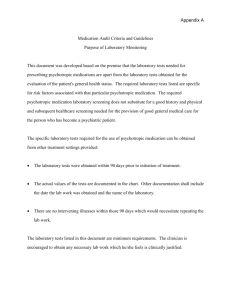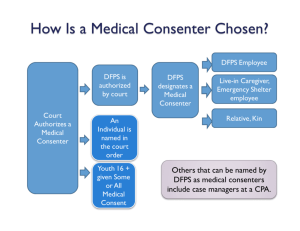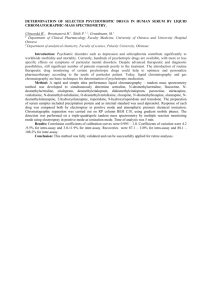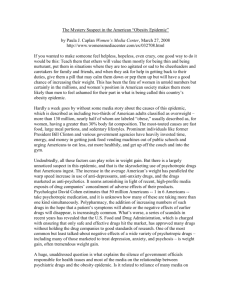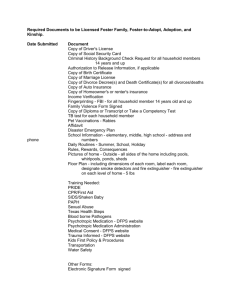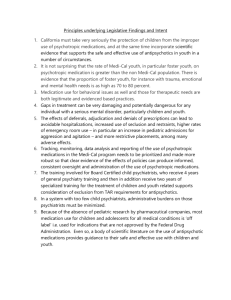Document 13308496
advertisement
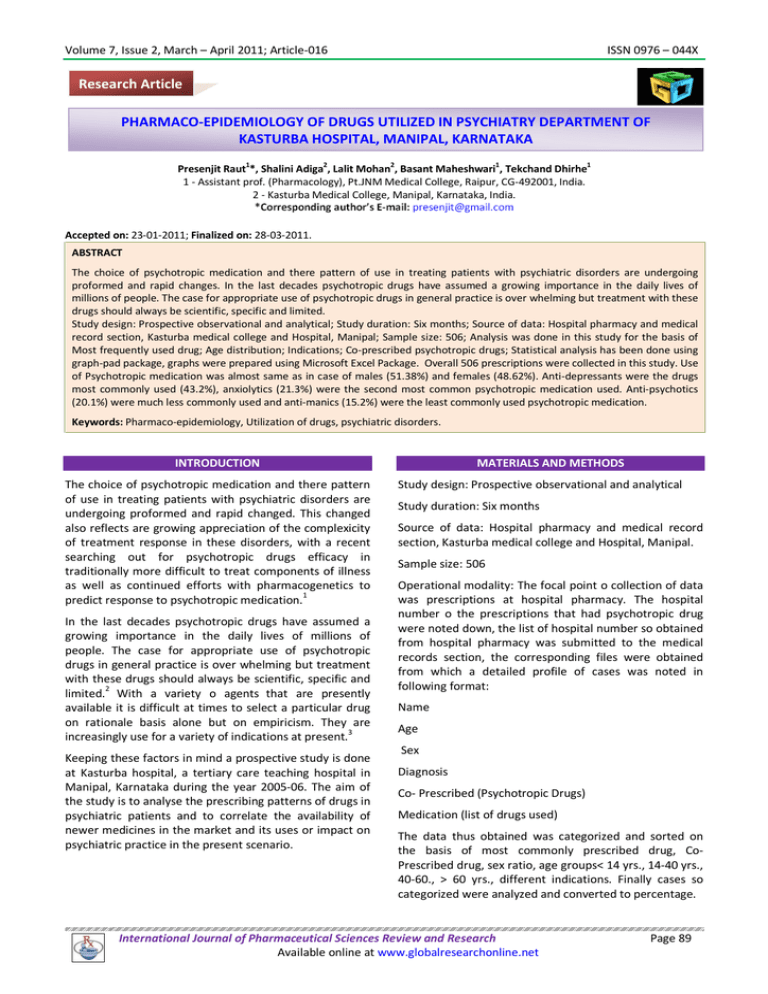
Volume 7, Issue 2, March – April 2011; Article-016 ISSN 0976 – 044X Research Article PHARMACO-EPIDEMIOLOGY OF DRUGS UTILIZED IN PSYCHIATRY DEPARTMENT OF KASTURBA HOSPITAL, MANIPAL, KARNATAKA 1 2 2 1 1 Presenjit Raut *, Shalini Adiga , Lalit Mohan , Basant Maheshwari , Tekchand Dhirhe 1 - Assistant prof. (Pharmacology), Pt.JNM Medical College, Raipur, CG-492001, India. 2 - Kasturba Medical College, Manipal, Karnataka, India. Accepted on: 23-01-2011; Finalized on: 28-03-2011. ABSTRACT The choice of psychotropic medication and there pattern of use in treating patients with psychiatric disorders are undergoing proformed and rapid changes. In the last decades psychotropic drugs have assumed a growing importance in the daily lives of millions of people. The case for appropriate use of psychotropic drugs in general practice is over whelming but treatment with these drugs should always be scientific, specific and limited. Study design: Prospective observational and analytical; Study duration: Six months; Source of data: Hospital pharmacy and medical record section, Kasturba medical college and Hospital, Manipal; Sample size: 506; Analysis was done in this study for the basis of Most frequently used drug; Age distribution; Indications; Co-prescribed psychotropic drugs; Statistical analysis has been done using graph-pad package, graphs were prepared using Microsoft Excel Package. Overall 506 prescriptions were collected in this study. Use of Psychotropic medication was almost same as in case of males (51.38%) and females (48.62%). Anti-depressants were the drugs most commonly used (43.2%), anxiolytics (21.3%) were the second most common psychotropic medication used. Anti-psychotics (20.1%) were much less commonly used and anti-manics (15.2%) were the least commonly used psychotropic medication. Keywords: Pharmaco-epidemiology, Utilization of drugs, psychiatric disorders. INTRODUCTION The choice of psychotropic medication and there pattern of use in treating patients with psychiatric disorders are undergoing proformed and rapid changed. This changed also reflects are growing appreciation of the complexicity of treatment response in these disorders, with a recent searching out for psychotropic drugs efficacy in traditionally more difficult to treat components of illness as well as continued efforts with pharmacogenetics to predict response to psychotropic medication.1 In the last decades psychotropic drugs have assumed a growing importance in the daily lives of millions of people. The case for appropriate use of psychotropic drugs in general practice is over whelming but treatment with these drugs should always be scientific, specific and limited.2 With a variety o agents that are presently available it is difficult at times to select a particular drug on rationale basis alone but on empiricism. They are increasingly use for a variety of indications at present.3 Keeping these factors in mind a prospective study is done at Kasturba hospital, a tertiary care teaching hospital in Manipal, Karnataka during the year 2005-06. The aim of the study is to analyse the prescribing patterns of drugs in psychiatric patients and to correlate the availability of newer medicines in the market and its uses or impact on psychiatric practice in the present scenario. MATERIALS AND METHODS Study design: Prospective observational and analytical Study duration: Six months Source of data: Hospital pharmacy and medical record section, Kasturba medical college and Hospital, Manipal. Sample size: 506 Operational modality: The focal point o collection of data was prescriptions at hospital pharmacy. The hospital number o the prescriptions that had psychotropic drug were noted down, the list of hospital number so obtained from hospital pharmacy was submitted to the medical records section, the corresponding files were obtained from which a detailed profile of cases was noted in following format: Name Age Sex Diagnosis Co- Prescribed (Psychotropic Drugs) Medication (list of drugs used) The data thus obtained was categorized and sorted on the basis of most commonly prescribed drug, CoPrescribed drug, sex ratio, age groups< 14 yrs., 14-40 yrs., 40-60., > 60 yrs., different indications. Finally cases so categorized were analyzed and converted to percentage. International Journal of Pharmaceutical Sciences Review and Research Available online at www.globalresearchonline.net Page 89 Volume 7, Issue 2, March – April 2011; Article-016 Analysis of the study This study was designed to critically evaluate the prescription pattern of Psychotropic drugs. A total of 506 prescriptions having Psychotropic drugs were collected, they were categorized into 4 groups-antidepressants, anti-anxiety, anti-psychotics and antimanics. These groups have been analyzed on the basis of: Most frequently used drug Age distribution Indications Co-prescribed psychotropic drugs Statistical analysis has been done using graph-pad package, graphs were prepared using Microsoft Excel Package. DISCUSSION in the present study carried out on out-patient in Kasturba hospital, Manipal we collected data regarding the specific compounds in each drug category, data presented in this dissertation are limited to four main categories, anti-depressants (including tricyclics, SSRIs, and atypical antidepressants), anxiolytics (including benzodiazepines and non-benzodiazepines), antipsychotics including traditional and atypical antipsychotics such as clozapine, olanzepine, resperidone, quetiapine and mood-stabilizers (including lithium, sodium valproate, carbamazepine). Anti-depressants utilization Antidepressants were the most commonly prescribed antipsychotic drugs (43.28%). Among them TCAs (tricyclics antidepressants) constituted 54% whereas SSRIs (selective serotonin reuptake inhibitors) were 36% followed by atypical antidepressants 10%). This is not in accordance with the previous study report, which suggests SSRIs to be the choice of antidepressants because of safety profile as well as better tolerability and compliance. The age group that most commonly used these drugs was the age group between 14-60 yrs. i.e. 14- 40 yrs. (42 %), 40-60 yrs. (41%), respectively and among the elderly the use was 17%, indicating a higher degree of depression among youth most common indication for the use of antidepressants was dysthymia 83% followed by recurrent depressive disorder 17%. Anti-anxiety utilization Among the antianxiety drugs alprazolam was the most commonly prescribed (54%) followed by lorazepam (31%), diazepam (9%), chlordiazepoxide (6%), suggesting a trend towards the use of shorter acting benzodiazepine, as it is seen that continuous and prolonged use of longer acting benzodiazepines has resulted in dependence and may have withdrawl symptoms when the dosage of these 5 drugs is reduced or treatment is stopped. The indications ISSN 0976 – 044X for which these drugs were used were BAD-Bipolar Affective Disorder (44%), anxiety (24%), Panic disorder (12%), Psychosis (10%), Migraine (10%), suggesting an overlapping of psychiatric disorders, in this case being Bipolar disorders, Anxiety and Psychosis. The age group having the maximum utilization of benzodiazepines was again the age group between 14-40 years (36%) and 4060 years (35%), while in case of elderly, the utilization was 19% and in age group <14 years it was 10% which is in accordance with the study done by Morgan and colleagues,6 where the prevalence of use of hypnotic drugs among patients aged 65 years or older was 16%. The co-prescribed psychotropic drugs were anti-manics (52%), anti-psychotics (30%), and anti-depressants (18%). Anti-psychotics utilization The treatment pattern observed correlates with the world-wide changing trends in the treatment of schizophrenia. In recent years, the introduction of newer atypical anti-psychotic agents like olanzepine, risperidone, quetiapine have provided a better control of symptoms and reduced adverse effects especially the extrapyramidal ones in contrast with older drugs. The newer atypical anti-psychotics also may be efficacious in neuroleptic resistant schizophrenia.7 In our present study the atypical anti-psychotics constitute 91.6%, whereas typical anti-psychotics made only 8.4% of the total anti-psychotics prescription. Out of total atypical anti-psychotics the major portion i.e about 51% was made by olanzepine, followed by risperidone (42%), Quetiapine and clozapine (3-4%). The typical antipsychotics constitute only 10% of the total anti-psychotic prescription with a major part formed by chlorpromazine (56%) followed by haloperidol and flupenthixol (44%). In our study males constitute 57% whereas females were 43%. The age group which formed the major portion was 14-40 years age group (60%), followed by 40-60 years (28%) and >60 years (11%), indicating that the major use of anti-psychotics was in the age group between 14-40 years whereas in children (<14 years) the use was only 1%. This finding is in accordance with the study done by Cheng-Shannon J et al, which showed significant increase in anti-psychotic prescribing for youths, mainly because of the growing use of growing use of second generation agents for non-psychotic indications.8 Indications for which anti-psychotics were used were as follows: Schizophrenia-26% Psychosis-26% Bipolar Affective Disorder – (BAD)-25% Persistent Delusional Disorder-(PDD)-6% Miscellaneous-17% These indications co-relate the use of mood-stabilizers along with anti-psychotics. The high prevalence of antipsychotics co-prescribed with mood-stabilizers (lithium International Journal of Pharmaceutical Sciences Review and Research Available online at www.globalresearchonline.net Page 90 Volume 7, Issue 2, March – April 2011; Article-016 50%) as well as anti-depressants and benzodiazepines (25%) is striking because the efficacy and safety of this association have not really been assessed in clinical trials. From pharmacological point of view this co-prescription may induce potentially deleterious interactions. For example some anti-depressants are known to raise resperidone plasma concentration and thus to increase the risk of its side-effects. Increased frequency of antidepressant side-effect with the concomitant use of 9 resperidone has also been reported. Lithium given along with haloperidol may increase CNS toxicity (tremor & rigidity), anti-psychotics may prevent nausea which can be a sign of Lithium toxicity, & also they can strongly potentiate sedative hypnotics. carbamazepine can induce microsomal enzymes and increase metabolism of antipsychotics. SSRIs compete for hepatic oxidases and can elevate circulating levels of neuroleptics10. This high frequency of co-prescription is not only to be explain by malpractice, but also indicates a real clinical need, it may reflect the frequent co-morbidity of mood disorders in schizophrenia. A strong implication of the present finding is that the combination of psychotropic drugs (anti-psychotics, mood-stabilizers, anti-depressants and anti-anxiety), which until now has not been widely studied for efficacy or safety, has to be further explored from a pharmacological and clinical point of view. Anti-cholinergic drug (Benzhexol) was prescribed with resperidone in about 53% cases where as olanzapine it was 47%,suggesting that despite the claim of lower incidence of extra-pyramidal symptoms as compared with conventional anti-psychotics this atypical anti-psychotics may induce the occurrence of such side-effects in alarge proportion of patient. To conclude atypical antipsychotics such as resperidone and olazepine have been marketed with the claim that they dramatically improve the quality of life of the subjects in need of anti-psychotic treatment, by reducing the need for co-prescription with anti-cholinergics. This study suggests that the frequency of co-prescription remains fairly high with these products, and that there is a gap between the guidelines regulating the prescription and actual clinical practice. Anti-manics/mood-stabilizing agents utilisation Lithium was most common anti-manic used (72%), followed by sodium valproate (14%) and carbamazepine (14%), which is in accordance with the study done by Sajatovoc M11. The age for which the utilization was the highest was the again the age group between 14-40 years (51%), followed by 40-60 years (45%) and for more than 60 years it was 4% respectively. The indicators for which mood-stabilizers were used were bipolar affective disorders (BAD) (88%) followed by BAD with Psychosis (12%), suggesting co-morbidity of bipolar disorders with psychosis and thereby suggesting the use of anti-psychotics along with lithium (68%), whereas the anti-depressants and benzodiazepines (lorazepam usage was 20% and 12% respectively). ISSN 0976 – 044X CONCLUSION The present study was aimed at evaluating the prescribing pattern of psychotropic drugs in Kasturba hospital, Manipal. The evaluation was done in comparison with the other studies. Overall 506 prescriptions were collected in this study. Use of Psychotropic medication was almost same as in case of males (51.38%) and females (48.62%). Anti-depressants were the drugs most commonly used (43.2%), anxiolytics (21.3%) were the second most common psychotropic medication used. Anti-psychotics (20.1%) were much less commonly used and anti-manics (15.2%) were the least commonly used psychotropic medication. From this study it was evident that the major consumers of psychotropic drugs were the age group between 14-40 years and 40-60 years (83.99%), and it was least common in paediatric age group (2.17%). The most common drug combination included the use of anti-psychotics with anti-manics (60%), suggesting an overlapping of these two conditions, but this combination also has got its disadvantages which have been discussed in detail in the discussion part of this dissertation. Despite some reservations, the prescribing of psychotropic drugs in general practice appears to be improving and is much more carefully monitored than it was 10 years ago. A large deficiency in our knowledge is the best way of managing those who take psychotropic drugs long term, usually in combination. REFERENCES 1. Buckley PF, Shendarkar N, Treatment of refractory schizophrenia.Curr Opin Psychiatry.2005:18:165-73. 2. Dennis PJ, Monitoring of Psychotropic drug prescribing in general practice.BMJ.1979 :(2):111516. 3. Dutta SB, Dhasmana DC, Bharadwaj R, Psychotropic drug utilization pattern among schizophrenics. IJ Psychiatry.2004:46(4):381. 4. Montgomery, Henry J, McDonald G, et al. Selective serotonin reuptake inhibitors: meta-analysis of discontinuation rates. Intern Clin Psychopharmacology, 1994, 9:47-53. 5. Tyrer PJ.Benzodiazepine dependence and propranolol. Pharmaceutical journal 1980:225:15860. 6. Morgan K, Dallosso H, Ebrahim S et al. Prevalence, frequency and duration of hypnotic drug use among the elderly living at home. British Medical Journal of Clinical Research.1988:296:601-02. 7. Serreti A, De ronchi D, Lorenzi C, Beradi D, New antipsychotics and schizophrenia: a review on efficacy and side-effects. curr Med Chem.2004:11(3):343-58. International Journal of Pharmaceutical Sciences Review and Research Available online at www.globalresearchonline.net Page 91 Volume 7, Issue 2, March – April 2011; Article-016 ISSN 0976 – 044X 8. Sajatovic M, Gerhart C, Semple W, Association between mood-stabilizing medication and mental health resource use in the management of acute mania. PsychiatricnServ. 1997:48(8):1037-41. 9. Bozikas V, Petrikis P, Karavatos A. Urinary retention caused after fluoxetine- risperidone combination. J Psychopharmacol.2001:15:142-43. 10. Benazzi F. Gynecomastia with risperidonefluoxetine combination. Pharmacopsychiatry. 1999:32-41. 12. Baldessarini RJ, Tarazi FI. Drugs and treatment of psychiatric disorders-Psychosis and mania. In:Hardman JG, Limbird LE. The Pharmacological basis of therapeutics. 10 ed. Mc Graw-Hill companies:2001.485-514. 13. Sajatovic M, Gerhart C, Semple W. Association between mood-stabilizing medication and mental health resource use in the management of acute mania. Psychiatry Serv.1997:48(8):1037-41. 11. Andrade C. risperidone may worsen fluoxetine treated OCD. J Clin Psychiatry.1998:59:255-56. ************** International Journal of Pharmaceutical Sciences Review and Research Available online at www.globalresearchonline.net Page 92
